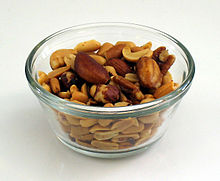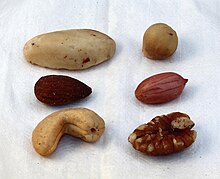

A culinary nut is a dry, edible fruit or seed that usually, but not always, has a high fat content. Nuts are used in a wide variety of edible roles, including in baking, as snacks (either roasted or raw), and as flavoring. In addition to botanical nuts, fruits and seeds that have a similar appearance and culinary role are considered to be culinary nuts.[1] Culinary nuts are divided into fruits or seeds in one of four categories:
- True, or botanical nuts: dry, hard-shelled, uncompartmented fruit that do not split on maturity to release seeds; (e.g. hazelnuts) [2][3]
- Drupes: seed contained within a pit (stone or pyrena) that itself is surrounded by a fleshy fruit (e.g. almonds, walnuts);[4]
- Gymnosperm seeds: naked seeds, with no enclosure (e.g. pine nuts);
- Angiosperm: seeds surrounded by an enclosure, such as a pod or a fruit (e.g. peanuts).
Nuts have a rich history as food. For many indigenous peoples of the Americas, a wide variety of nuts, including acorns, American beech, and others, served as a major source of starch and fat over thousands of years.[5] Similarly, a wide variety of nuts have served as food for Indigenous Australians for many centuries.[6] Other culinary nuts, though known from ancient times, have seen dramatic increases in use in modern times. The most striking such example is the peanut. Its usage was popularized by the work of George Washington Carver, who discovered and popularized many applications of the peanut after employing peanut plants for soil amelioration in fields used to grow cotton.[7]
- ^ Bewley, J. Derek; Black, Michael; Halmer, Peter (2006). The encyclopedia of seeds: science, technology and uses. CABI. p. 444. ISBN 0-85199-723-6. Retrieved 2011-11-21.
- ^ "Nut". The American Heritage® Dictionary of the English Language (Fourth ed.). Houghton Mifflin Company. 2000. Retrieved 2011-11-21.
- ^ "Nuts and derived products". Definition and Classification of Commodities. Food and Agriculture Organization of the United Nations (FAO). 1996. Archived from the original on 2018-12-24. Retrieved 2011-11-21.
- ^ "Drupe". Collins English Dictionary – Complete and Unabridged 11th Edition. Harper-Collins Publishers. 2012. Retrieved 2012-09-05.
- ^ Moerman 2010.
- ^ Clarke, Philip A. (2008). Aboriginal plant collectors: botanists and Australian aboriginal people in the nineteenth century. Rosenberg Pub. ISBN 978-1-877058-68-4. Retrieved 2011-11-21.
- ^ "History of peanuts". National Peanut Board. Archived from the original on 2007-10-23. Retrieved 2011-11-22.
